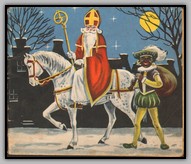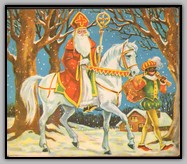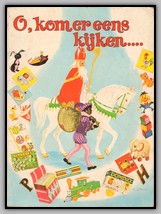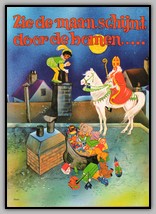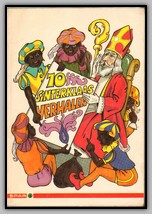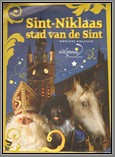COLLECTION OF CHILDRENS BOOKS ON ZWARTE PIET (BLACK PETE)
In the folklore and legends of the Netherlands and Belgium, Zwarte Piet (meaning Black Pete) is a companion of Saint Nicholas (Dutch: Sinterklaas) whose yearly feast in the Netherlands is usually celebrated on the evening of 5 December and 6 December in Belgium, when they distribute sweets and presents to all good children. The characters of Zwarte Pieten appear only in the weeks before Saint Nicholas's feast, first when the saint is welcomed with a parade as he arrives in the country (generally by boat, having traveled from Madrid, Spain). The tasks of the Zwarte Pieten are mostly to amuse children, and to scatter candies for those who come to meet the saint as he visits. According to myths dating to the beginning of the 19th century, Saint Nicholas operated by himself or in the companionship of a devil. Having triumphed over evil, it was said that on Saint Nicholas Eve the devil was shackled and made his slave; a devil as a helper of the saint can still be found in the Austrian Saint Nicholas tradition, in the character of Krampus. Another explanations is that Pete is an Ethiopian slave freed by St. Nick, or a Moor with origins in Spain. The lyrics of older traditional Sinterklaas songs warn that while Sinterklaas and his assistant will leave well-behaved children presents, they will punish those who have been very naughty. For example, they will take bad children and carry these children off in a burlap sack to their homeland of Spain, where, according to legend, Sinterklaas and his helper dwell out of season. These songs and stories also warn that a child who has been only slightly naughty will not get a present, but a "roe", which is a bundle of birch twigs, implying that they could have gotten a birching instead, or they will simply receive a lump of coal instead of gifts. Until the second half of the 20th century, Saint Nicholas' helper was not too bright, in line with the old colonial traditions. Once immigration started from the former colonised countries, Zwarte Piet became a much more respected assistant of Saint Nicholas, often inattentive, but playful. Zwarte Piet is today commonly depicted as a black person in the colorful pantaloons, feathered cap and ruffles of a Renaissance European page, a tradition that comes from a children's book published in 1850. Attempts to make him more politically correct suggest that Black Pete’s black face is actually the result of climbing down chimneys to deliver presents. The subject of Zwarte Piet is highly controversial. "It has to be the most racist celebration in contemporary Western civilization,” writes Anthony Murrell, a black American resident of Amsterdam. “It serves as a virtual assault on all black and brown people living in Holland.” In a Facebook post to civil rights campaigner Rev. Al Sharpton, Murrell argues for cultural sanctions against the Netherlands in response to Black Pete.

